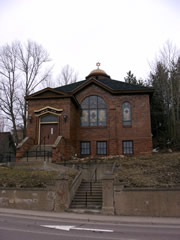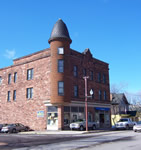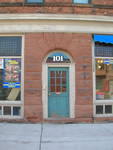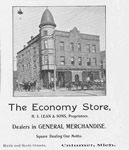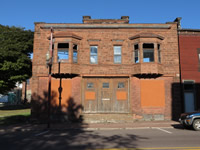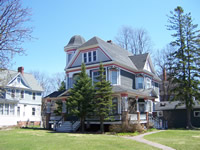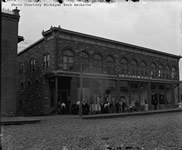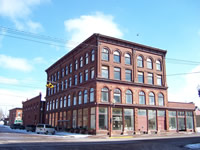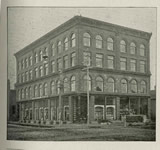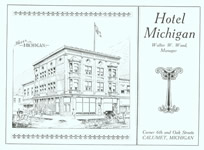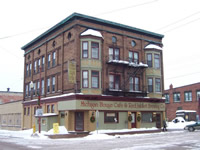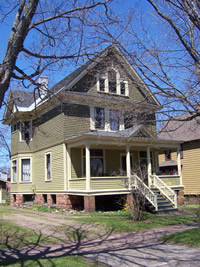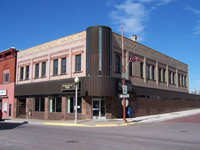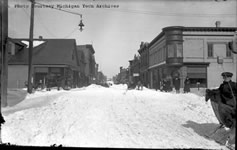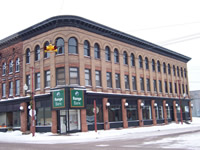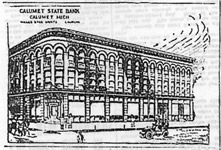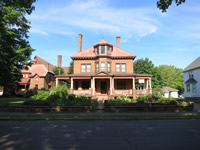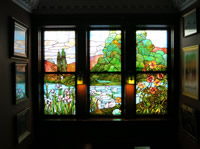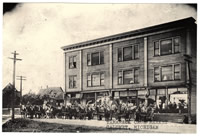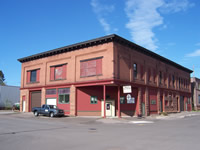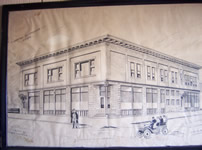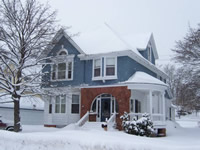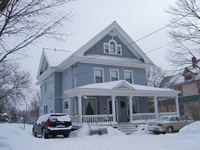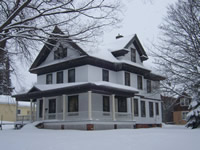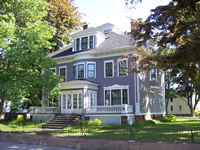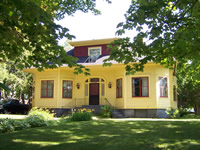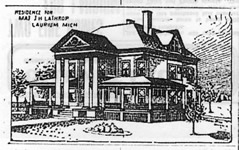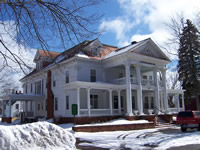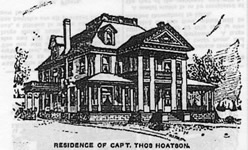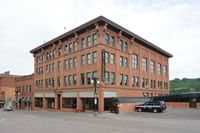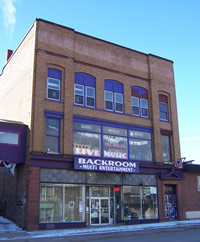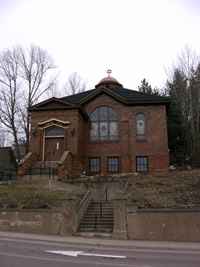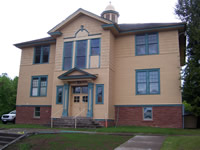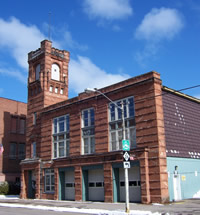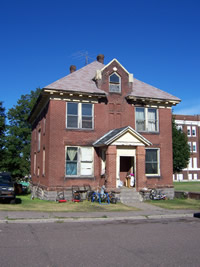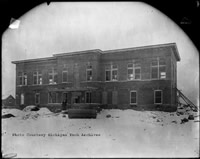Buildings by Charles Maass (ca. 1895-ca. 1905)Kinsman Block (William Wayner Building) W.C. Kinsman learned the trade of harness-making in Cornwall and established a business in Red Jacket in 1872. He engaged Maass to draw the plans for a building to serve as commercial space and apartments. Maass designed a three-story Portage Entry sandstone structure measuring 75’ x 80’. The northwest corner features a shingled turret with a dome, while a galvanized metal cornice runs along the top of the building. Two first-floor storefronts are separated by the entrance leading to two floors of apartments. The round-arched center entrance is positioned below a center gable. The building was completed for $14,000 in 1898 by local workmen. P.P. Roehm is credited as the mason and Bajari and Ulseth as the carpenter. The Copper Country Evening News reported the following specifications on March 18, 1898:
A few weeks later, the same newspaper explained the new technology applied to deal with the local weather conditions.
The newspaper also stated that the Kinsman Block was “more pretentious than any building so far erected in the village and reflects credits upon the architect.”
Hermann Building Joseph Hermann had this combination commercial-residential building constructed. The walls of uncoursed ashlar sandstone are complemented by a pressed metal cornice and window hoods. High-grade, purer red sandstone is used on the front, while the sides and rear are of a poorer grade. The 48’ x 68’ building had two stores on the first floor; the plate-glass windows have been replaced with brick infill. On the second floor, denoted by two pressed-metal oriels, were two flats, each of nine rooms. As the newspaper noted, “each flat will have entrances from the front and rear and will be supplied with all modern improvements including open fireplaces. The building will be lighted with gas.”15 The building is currently very deteriorated; the roof has collapsed.
Fichtel House Charles L. Fichtel, a druggist, commissioned this grand house in 1899. The newspaper described it as being in the “English style,” probably meaning Queen Anne Revival. The jerkinhead-gable roof, cross gable, three-story tower, porches and projections, and various sidings of clapboards and shingles all contribute to this effect. The newspaper also noted that it cost about $8,000 to construct.16 The reception room had a grand staircase, a fireplace with onyx mantel, and an inglenook. The parlor, finished in birds-eye maple, had a bay window. It was connected with sliding doors to the sitting room which measured 44 by 16 feet and also had a bay window and fireplace, finished in white oak. The dining room had “large column portiers between and an elegant china closet.” Upstairs were five bedrooms, each with a closet. The front bedroom had access to a balcony.17 Vertin’s Department Store John and Joseph Vertin established this department store, which grew to be biggest in the Copper Country.
In 1899-1900, two brick stories were added to the existing sandstone building. The original building had a row of round-arched windows at the second level topped by a modest cornice. In the addition, Maass maintained the same fenestration, with flat-arched windows with sandstone lintels on the third level and round-arched on the fourth. A bracketed cornice tops the building. The Copper County Evening News crowned the remodeled store as the largest in the Upper Peninsula in an article written for the September re-opening:
The building currently houses art studios and galleries.
Michigan House Built for the Bosch Brewing Company, the Michigan House is a roughly square building, four bays by four bays, with two storefronts along Oak Street and a central doorway to upper floors. The corner storefront with a recessed corner entrance was historically occupied by a saloon designed to feature Bosch Brewing Company products, with a largely intact interior, including oak booths and murals painted by Associated Artists of Milwaukee. The east storefront was occupied by a restaurant dining room which also retains some historic interior features, including a large Moorish-inspired arts and crafts fireplace. On the exterior of the building, the Oak and Sixth Street facades are divided by pilasters into four bays on each face, with a copper cornice. The center bays on the front of the building have paired windows, and are flanked by two-story oriel windows. Bull’s-eye windows top the bays without oriels. The second and third floors of the building may have been divided into four two-room "bachelor" flats, each with a sitting room with a fireplace and a bedroom, separated by pocket doors. Tenants would have taken their meals in the dining room downstairs. The upper floors were later converted into conventional apartments. The building still houses a bar and restaurant.
Charles Maass House Charles Maass bought a small house on this site, enlarged it, and lived in it for several years.21 The front gable with Palladian window and cross gable over a bay window were features repeated in houses he would design over the next few years, such as the Weir and Ulseth houses. Maass’s house has a Jacobsville sandstone foundation, clapboards on the first floor, and wood shingles on the second. The porch across the front has Ionic columns. Buildings by Maass Brothers (ca. 1905-1913)Jacka Block Walter Jacka, partner in Jacka and Sullivan Livery, whose stable was located in the rear of this lot, commissioned this building when his previous building on the site was destroyed by fire. The new building was predicted to cost $20,000. Before construction started, the plan was to divide the first floor into two stores. The newspaper said that the north storefront had been let to jeweler John Ellis, and that its corner entrance was intended to be an “artistic” entrance: “An archway will be built over the door with magnificent sandstone copings,” which had already been fabricated. The other store was not yet leased, but it appears that when Merchants & Miners Bank became the tenant, it occupied both store spaces. The stairway to the upper floor was located along the north wall of the building. The offices on the second floor included the quarters of the Calumet & Arizona Mining Company, which occupied a 16’ by 20’ counting room and a 7’ x 12’ vault, along with other rooms.22 The building has suffered some unfortunate exterior renovations. The two-story building’s cornice has been removed, the round oriel at the corner has been enclosed, and the first-floor storefronts have been compromised. The unusual light-colored brick was “made from the conglomerate stamp sand taken from the old Albany & Boston mine, which is now the Franklin Junior mine.” On the interior, the brick came from the Lake Superior Sand Lime Brick Company in Ripley. The sandstone for the coping, sills, and lintels came from the Traverse Bay Red Stone Company.23
Calumet State Bank The newly formed Calumet State Bank commissioned this handsome structure in 1906.24 Situated on the corner of Oak and Sixth Streets, the building was designed to complement the Coppo Block adjacent to it on 6th Street. Both are three stories with round-arched windows at the third story. The bank building is faced with Minneapolis pressed brick with sandstone trim. The façade, which curves around the corner, is topped with a galvanized-iron modillioned cornice. The corner entrance led to a lobby that stretched along the Oak Street side. The banking room had a tiled floor, marble baseboards, and mahogany furniture. Both gas and electric fixtures were provided in the building. The upper floors were finished with quarter-sawn oak.
MacDonald House Norman MacDonald, born in Germany in 1864 to a Scottish father and a Norwegian mother, immigrated as a child to Calumet. His father owned a drugstore at 100 Fifth Street in Calumet. Norman MacDonald took over the business in the late 1890s, living over the store with his wife, Minnie. By 1905, though, MacDonald had retired from the business. He built this large house and moved to Laurium. The source of his wealth was apparently the Calumet & Arizona Mining Company, in which he had invested. Norman and Minnie MacDonald lived in this house with two servants; their only son died in 1908.26 It is not known how MacDonald happened to have hired the Maass Brothers as his architects, but it was probably through MacDonald that Hoatson, president of the Calumet & Arizona Mining Company, met Maass and commissioned him to design his much larger house across the street. The MacDonald House is more in the arts-and-crafts mode, with its blocky form and stained glass. The walls of the two-and-a-half-story house are a smooth brown brick with red mortar, accented with quoins and sandstone trim. The blockiness of the house is broken through in several ways: a bay window on the first floor in the front, a copper-clad oriel at the second and third floors in the center of the front, a bowed window on the side, denoting the dining room, and gable dormers in the hipped roof. A wraparound porch with fluted Corinthian columns and the cornice with modillions and dentils add some Classical touches. Inside, the rooms are decorated with wood paneling and coffering, elaborate overmantels, tiled fireplaces, and delicately plastered ceilings. The most notable ornament, though, is the tripartite stained-glass window on the stairway landing, depicting a landscape scene. The house is accompanied by a two-story carriage house of similar materials. The MacDonald family owned the house until 1961. Currently, the house is a bed-and-breakfast, part of the Laurium Manor Inn complex.
Tamarack Co-operative Store Hailed as the “largest retail outlet north of Milwaukee,” the Tamarack Co-operative Store was also one of the most successful co-ops in the United States. Supported by mine managers, the store kept retail prices low throughout the Copper Country, allowing managers to keep wages correspondingly low.27 The Co-op was apparently the idea of Robert W. Bennett, an immigrant from Northumberland, England, who had had experience with similar endeavors. He interested John Daniell, who was the general manager of the Tamarack Mining Company. When the co-op opened in 1890, the board of directors was dominated by mine managers, although four of the nine directors were mineworkers. The store was capitalized at $100,000 in $10 shares. After a few years, important changes were made to the organizational structure, diminishing the influence of mine managers. A one-man-one-vote method of representation was instituted, no one was allowed to acquire more than twenty shares, and dividends were paid on the basis of purchases. The store generally paid 8% dividends on capital paid in, and 12% to 13% on purchases. In 1912, the company paid out $103,947 in dividends to 1,814 shareholders and had sales of $845,930. Since its organization, it had paid out $1,144,006 in dividends.28 The store sold groceries, meats, clothing, furniture, hardware, drugs, and more. Its slogan was “the store of the people, by the people, and for the people: if you can’t come to the store, we’ll bring the store to you.” The store delivered daily within a three-mile radius of the store, three times a week beyond three miles but within eight, and three times a month to sites farther out. It had a large teamster department. At one point the store had 6,000 people on its credit books and 125 on its payroll. Sales reached $1 million a year and the enterprise was allegedly the subject of study in New York University’s business school.29 The store consisted of an accumulation of buildings built over many years, but in 1907 the Maass Brothers designed a $14,000 remodeling of the flagship store building. When completed, the three-story building measured 84’ x 119’, with a floor space of about 40,000 square feet. The first floor had large plate-glass windows and the second floor had Chicago windows, beneath a modillioned cornice. On the upper levels, pilasters divided the bays. The building was wood frame with clapboard siding. Besides the retail space, the building also included a safe on the first and second floors, offices on the first floor, lunch room and toilets for employees on the second floor, a large rest room for employees on the third floor.30 Croatian Co-operative Store The Croatian Co-Operative Company formed in about 1906 and built this store building. Officers were William Mihelcich, President; Frank Stepech, Secretary; Matti Drazich, Treasurer; and John Agnich, Manager. They offered general merchandise and claimed to be “The Largest Co-Operative Store in Calumet,” a challenge to the Tamarack Co-op. By 1912, though, the Croatian Co-operative Store was out of business.32 The two-story, 74' x 118' building had a canted corner entrance and large plate-glass windows topped with prism glass. The first-story walls were Jacobsville sandstone and the second-story brick. A modillioned cornice topped the building. On the second floor of the 7th Street façade, three Chicago-style windows were set in large brick panels, while paired windows filled the panels on the Elm Street side. The store occupied the 7th Street side of the building on both the first and second floors. On the Elm Street side, space was prepared for a meat market, with a large refrigerator, that would be operated independently from the store. Above the meat market, three four-room flats, each with a separate bath, were available for rental. 33
Sibilski House This house was built sometime between 1905 and 1908 for T. Sibilski and family. Copies of undated drawings executed by the Maass Bros. are located in the Keweenaw National Historical Park archives. The asymmetrical house is particularly notable for its arched sandstone entranceway, all the more remarkable because it is attached to a wood-frame house clad in shingles on the first floor and clapboards on the second. The two-story house has a broad hip roof with a cross gable in front and a gable dormer on the side. A Palladian window on the second-floor front indicates some Classical Revival influence. The rounded porch to one side and the variety of window shapes and projections make this a lively design.
Weir House Captain William Weir, retired from the Calumet & Hecla Mining Company, had this house built for himself and his family in 1907. Even the newspaper noted the similarity of this house to Edward Ulseth’s. The two-and-a-half-story house has a cross-gable roof with a Palladian window in the gable. Estimating the cost at $15,000, the newspaper described the interior: “The first floor contains a tiled vestibule leading into a large reception hall. The other rooms are a large parlor, sitting room, den, dining room, kitchen and the usual closets and pantries. The den is a very attractive room with beamed ceilings and a beautifully decorated.”34
Ulseth House Edward Ulseth, the noted Calumet builder, had the Maass Brothers design this house and probably built it himself.35 The large house with cross-gabled roof is set on a large lot. The one-story porch wrapping around the front and the Palladian window in the gable are the most distinguishing features.
Milligan House Captain James Milligan commissioned the design of this house from the Maass Brothers. Construction was completed in 1907.36 The two-and-a-half story house is in the Classical Revival style. Its high hip roof has hip-roofed dormers and a clerestory. Corner pilasters and a modillioned cornice ornament the blocky structure. Very thin clapboards cover the wood frame; the foundation is Jacobsville sandstone. There is a balustraded terrace across the front. Above an enclosed porch, the center bay of the front is bowed. There is a bowed oriel on one side of the house and a bowed bay window on the other. According to a contemporary account, the house was "modern in every respect and beautifully finished in the interior. Quarter sawed oak, mahogany and birds eye maple are used in various rooms as finishing material. The rooms on the two floors are admirably appointed. The basement too is an ideal one, while quarters are also provided in the third floor for several persons."37 Lathrop House J. H. Lathrop, Calumet & Hecla's chief clerk, commissioned this 47’ x 64’ house in 1906 but did not live to see its completion. The Colonial Revival-style house was two-and-a-half stories tall with a two-story portico. A one-story porch wrapped around the front. Two-story bay windows flanked the portico. The wood-frame house, sided with clapboard, was built on a stone foundation. It was noticeably similar in appearance to the Hoatson House. The first floor featured a grand reception hall, 14’ x 22’ with a fireplace at the far end, finished in mahogany with a beamed ceiling. The first floor also had a reception room, library, den, dining room, kitchen, and pantries. The second floor contained four bedrooms, two bathrooms, a sewing room, and a dressing room. The third floor had four bedrooms, a bathroom, a “cedar room,” and storage spaces. The house was estimated to cost $25,000.38 Construction was completed after Lathrop’s death; the Guck family were later residents. At some point, the second and third stories were removed. The building is now one-and-a-half stories with a large shed-roofed dormer.
Hoatson House (Laurium Manor Inn) The Hoatson House was designed by the Maass Brothers and built in 1908 for Thomas H. and Cornelia Hoatson, owners of Calumet & Arizona Mining Company. The hip-roofed house has gable dormers and a wraparound porch. Colonial Revival elements include the general symmetry, two-story pedimented portico, Corinthian columns, and modillioned cornice. The interior is especially finely finished, with some Art Nouveau detailing. The reception hall is 12’ x 40’ with mirrors at the far end and a triple staircase off to the side. The first floor contains a 23’ x 23’ library, a 17’ x 23’ dining room, a reception room, and a den, as well as kitchen and pantries. The second floor contained six bedrooms and three bathrooms. The newspaper noted that “a broad balcony will be reached from the second floor providing a cool place for spending warm summer days.”40 The third floor contained three bedrooms, a bathroom, a “cedar room,” and a 50’ x 50’ billiard room. A “model stable” was also provided. This grand house was built for $50,000 and furnished for $35,000. The Laurium Manor Inn, a bed-and-breakfast, is available to tour.41
Masonic Temple of Houghton (City Centre) The four-story building is faced with Jacobsville sandstone. Smooth-faced pilaster-like elements are set off against the rough texture of the rest of the wall. Windows are grouped into threes across the front, except for the center bay, which is only one window wide and has a handsome pedimented doorway at ground level. The wide cornice is supported by oversized brackets. Masonic emblems decorate the frieze between the brackets and the pediment of the doorway. The Masons occupied the third and fourth floors, with a large dining room on the east and a theater on the west. Ground-floor retail and second-floor office rental spaces generated income to support the building. The building is now occupied by Houghton city offices and other offices as well.
Independent Order of Odd Fellows This large brick building has lost its cornice and the third-floor windows have been partially filled in, but its facade still retains its general appearance. At ground level, a large storefront fills most of the space, with a doorway to the upper floors at one side. The second floor has large plate-glass windows, whle the third has segmental-arched windows, paired in the center three bays. The Oddfellows occupied the third-floor hall of this building. By 1937 George Kirkish leased the building for his furniture store, buying the building in 1950. The family sold the building in 1995.
Temple Jacob Temple Jacob is the only synagogue in the Copper Country. Before the temple was built the services were held at the houses of different members. Henry Pimstein, Henry Feldman, J. Gottliebson, J. Green, and most notably, Jacob Gartner, decided to establish a Jewish temple.44 The Quincy Mining Company donated the land the temple sits on, but the founders still required $10,000 dollars for construction.45 Jacob Gartner was willing to lend a large portion of his personal money to see the temple built, and his generosity was honored by having the temple named after him.46 According to documents in the possession of the congregation, it purchased the plans, specifications, and superintendent abilities from Maass Bros. Architects.47 J. J. Kelly built the temple foundation for $610, and then A. J. Verville completed the superstructure for $4,686.48 The congregation of Temple Jacob is considered the “First Congregation of Israel.” The 40’ x 40’, hip-roofed structure is topped by a small copper dome. The foundation was constructed of Jacobsville sandstone. A vitrified glazed brick was used for the walls. Windows are round-arched, with stained glass that depicts a dove with an olive branch, shofar (ram’s horn), burning bush, Noah’s ark, hands in blessing, Star of David, eternal light, and the tablets of the Ten Commandments.49 Inside, the layout of the temple follows normal Jewish customs, with the altar facing east. A balcony was once used to separate the men and the women during prayers.
Chassell High School Among their many school commissions, the Maass Brothers designed Chassell’s first high school. The newspaper described it:
The school, which served until 1992 and is now in private ownership, survives virtually unaltered. The two-story building has a high hip roof with cupola. The center section of the front, which contains the stairway, projects and supports a pediment. Clapboard siding on the first level and shingles on the second highlight the use of wood in this lumber town. The similarity of the design of the neighboring Southwell Elementary School, built in 1917, would suggest that Maass designed it also, but no documentation has been found to support this. Buildings by Fred Maass (1913-ca. 1920)
Laurium Village Hall In 1899 the recently incorporated village of Laurium built a new village hall, a two-story building with false front. Fifteen years later, the village decided on an expansion and remodeling, and hired Fred Maass to prepare the plans. It is the only credit found of his solo work. The bid was awarded to Chatel and Vairo, contractors, for the sum of $7,990. The renovated building was dedicated on November 24, 1914.51 The original brick-veneered front was redone in Jacobsville sandstone; wide smooth-faced courses alternate with thin rough-faced ones. The second- and third-floor windows are arranged in three bays, separated by spandrel panels. At ground level are three vehicle doors. On the north side of the existing hall, the renovation included a two-story addition which measured 13’x 60’ with a crenellated four-story tower. The Michigan Conractor and Builder said that the new addition would contain the offices of the clerk, marshal, treasurer, and secretary of the water board, as well as the council chambers. In the rear of the building was the jail. On the second floor, above the fire station, were dormitories.52 The sandstone was reused from village gutters, which had been replaced with concrete. Buildings by Charles W. Maass (1913-ca. 1920)
St. Anthony of Padua Convent The Polish Catholics of Calumet formed a congregation, St. Anthony of Padua, in 1882 and built a small wooden church on lots donated by Calumet & Hecla. In 1892 they enlarged it, adding a tower in the center of the front and an ell in the rear for a school.53 In about 1907 the congregation built a new church, which was also wooden. It measured 40' x 75', seated sixty parishioners, and cost $2,900.54 It also had a school in an ell on the rear. In 1914, the parish added a convent building on the lot north of the church to house the nuns who taught in the school.55 In about 1928, the church was deconsecrated and demolished, and the remaining parishioners joined St. Joseph's. The parish sold the convent building to Faith Lutheran Church for its parsonage. The building later became a private home. The convent is a two-story, hip-roofed foursquare building measuring 30' x 40'. The brick walls are trimmed with sandstone; the foundation is concrete block. The symmetrical façade has paired windows, a gabled porch, and a wall dormer in the center.
Quincy Mining Company Clubhouse The two-story building for the Quincy Mining Company served as the company’s club house and bathhouse. The brick building was in a modest Italian Renaissance Revival style with keystones over the paired windows and a flat roof with wide eaves and a modillioned cornice. The bathhouse, with separate facilities for men and women, was located on the first floor, along with quarters for the resident caretaker. The second floor contained a large lecture room, a men’s room renamed a “foremen’s room” before construction was completed, and a library.56
|
